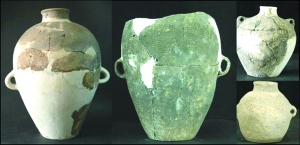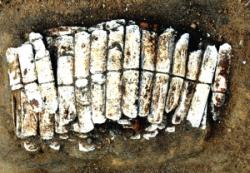Chinese Institute of Archaeology
Source - http://www.kaogu.cn/en/detail.asp?ProductID=3671
The Haminmangha (meaning small sand dune in Mongolian language) Site is located 20 kilometers south-east in the Shebotu town, Kezuozhongqi of Inner Mongolia. It is 50 kilometers south of Tongliao city in between West Liao River and its new tributary. The site is in a hinterland within the Khorchin sand zone, which is in the eastern plain of the West Liao River. In addition, the site is situated at the southern slope of a sand hill area in relatively high altitude. An ancient river course surrounds the northwestern part of the site whilst the landform of southeastern part is flat with sand dunes, meadows and occasional lakes scattering.
From May to November 2011, an excavation with an area of around 3,000 sq. meters was jointly conducted by the Institute of Archaeology and Cultural Relics of Inner Mongolia and the Jilin University Frontier Archaeological Research Centre. In 2010, a rescue excavation had already been conducted in the northeastern part of the site with an approximate 1,100 sq. meter excavation area. The accumulated exposure is therefore more than 4,000 sq. meters, which is regarded as the first large-scale excavation of a prehistoric settlement site above the 43rd degree of Northern Latitude. Based on the initial information, the overall area of the site was around 100,000 sq. meters and probably was the central area of the settlement site in Khorchin area. Various major archaeological discoveries already raised the awareness in academia.

From 2010 to 2011, 43 house foundations, 38 ash pits, six burials and one surrounding trench were identified in the Haminmangha site. Judging from the layout of the settlement, all house foundations were oriented in northeastern to southwestern direction and aligned from northwest to southeast direction. At least 11 rows of houses were identified in the site and each row consisted of three to five house foundations in regular intervals. Circular or oval shaped ash pits with flat bases were scattered around the houses. However, only few artifacts were retrieved from these pits. Six burials, which were earth shaft pits, were found within the house foundations. Only one multiple burial contained three persons in flexed positions, while the rest were single crouched inhumations. However, almost no burial item was discovered. The excavation fully exposed the outer boundary. A trench surrounded the eastern, western and northern sides of the settlement in an arc, while the western and northern flanks were connected by the ancient river course.
House foundations of the Haminmangha site were either rectangular or square. The doorways of these semi subterranean dwellings were located at the southeastern side of the convex shaped living rooms and directed uniformly in between 130°~145°. Four styles can be classified based on the area (doorways not included): There were nine small size house foundations with areas of less than 10 sq. meters, the smallest measuring 6.8 sq. meters only. The largest quantity (22 in total) was medium sized house foundations with an area between 10 to 15 sq. meters. Furthermore, there were six medium large house foundations with the area ranging from 15 to 20 sq. meters. And finally there were six large house foundations covering an area of over 20 sq. meters, the largest one measuring around 38 sq. meters. The house foundations had straight sides and were around 0.3-0.5m below ground. The deepest one was 0.75m while the shallowest one was only 0.1m. The living surface was flat and traces of burning were found in them and on the sides of some well-preserved house foundations. The color was reddish brown or blackish brown, and the depth of the partially burned area was around 2-3cm. The shallow, circular stove was located in the central portion of the living area near the doorway. On their hard fired bottoms, some greenish grey glazed texture was identified. Horseshoe shaped stove circles were also identified. A number of pottery tools (supporting legs) were found inside the stove, as well as plant ash on the bottom of the stove. Two types of postholes, namely full holes and half ones can be classified. They were found in regular intervals along the inner walls of the semi-subterranean houses, the four corners of the stove or symmetrically on top of the living surface.
Artefacts were concentrated on the living surface of the house foundations; only few artefacts can be identified within the house deposit. It was noted that several complete pottery vessels, stone tools, bone tools or even a set of production tools were discovered along the outer edges of the semi subterranean dwellings.

In the 2011 excavation, traces of wood fragments in various conditions, which belonged to fallen rooftops, were identified in seven house foundations. Human skeletons were identified on the living surface of three houses. F32 was the largest house and collapsed due to fire and copious charcoal sticks were overlying in a room. After detailed assessment, the fragmental wood structure was exposed and basically revealed the architectural framework of the roof. The crossbeam was located in the centre of the house and the four corners were supported by pillars. The ridgepole was built on top of the main beam with one edge connected to the ground and the other edge positioned in the middle. Rafters were set in between the ridgepole in regular intervals. An interlocking framework was formed among ground beam, ridgepole and rafter. Based on the initial assessment, the rooftop of the house foundation was a square tapered structure slandering in four sides. The Haminmangha site revealed a rather intact prehistoric housing framework and it was the first time, such was discovered in the northeastern and northern areas.

F40 was located at the southeastern corner; the shape and structure were similar to other semi subterranean dwellings with an area of 18 sq. meters. However, 98 human skeletal remains were identified in the living surface of this house. Except the southwestern corner, all skeletal remains were stacked together and revealed a shocking scenario. Based on the observation, 21 individuals can be identified through their sex and there were seven males and 14 females. The ratio of men to women was 1:2. 56 individuals can be identified from their age and the average age of death was 26.27 years. 12 non adult bodies were found and 46 adult bodies were identified, the ratio between adult and non-adult being 1:3:8. The human skeletons were laid down in different ways including flexed, prone or sideway positions and their heads faced in various directions. At least nine skulls were stacked together in the northeastern side and similar phenomena could be seen in the central area of the house and the doorway. Large amount of human skeletons were found within a cramped space and these skeletons were unearthed from the house foundations but not buried in a burial, thus this can be confirmed that they were not dying naturally. It is rare to see such large amount of human skeletons on the living surface of houses and this feature is deemed to be one of the important features of this excavation.


More than a thousand artefacts were identified in the Haminmangha site including pottery vessels and tools made of stone, jade, bone, horn, clams, etc. A set of cylindrical pots was unearthed in the living surface of the house foundation together with pots having a slender rim and deep bodies, jars with small rims and double ears, flat basins with everted rims and everted rim dishes with shallow bodies, all forming the basic combinations of pottery vessels. Stone tools including ploughs, axes chisels, knifes, grinders, polished sticks, pestles, basin style tools, rounded tools, arrowheads and mixed tools with stone blades attached were identified. The quantity of jade tools was small, but the materials for disk bi, rings, and axe yue were exquisitely selected and the implements well made. The typology was similar to those in Liaoxi area of Hongshan culture. Finally, productive tools including bone and horn tools, bone stackers, bone pricks, bone needles, bone arrowheads, horn pricks, etc. were identified.



The Haminmangha site was the largest scale excavation for a prehistoric settlement site with a surrounding ditch in Khorchin area. The settlement was well preserved with an enormous amount of artefacts and full of local regional characteristic. The formation of the housing site of the Haminmangha site, burial style and custom has also strong regional archaeological characteristics. Also the general combination of pottery shows distinctive characteristic including pit pattern, lattice pattern, etc. The artefacts were different from the Neolithic culture discovered in Liaoxi area. Furthermore, the production tools including stone ploughs, stone chisels, grinders, polished sticks, basin tools, stone pestles, bone pricks, bone stackers, clam knifes etc. were different from other archaeological cultures in the surrounding areas. This genre can only be seen in the Khorchin area situated at the northern part of the West Liao River, dating around the late Hongshan period. The scale of excavation in the Haminmangha site was the largest of its kind. Stratigraphies of this site were clear and the artefacts unearthed were distinctive. Therefore, we are going to name this features as Hamin Culture. (Translator: Andy Yiu)